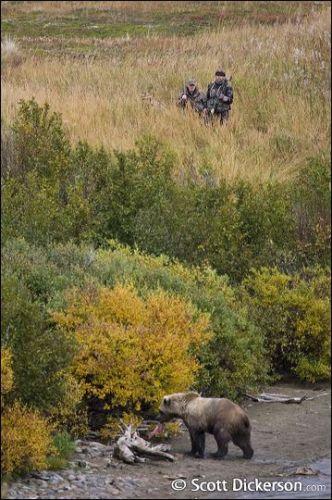For many Lower 48ers, the state of Alaska is perceived as a big, raw chunk of wilderness, complete with booming wildlife populations. And perhaps it is, but there's a growing concern that Alaska's wildlife managers are getting carried away with their bag limits on national park landscapes.
Few can forget the uproar over the fall 2007 brown bear hunts in Katmai National Park and Preserve. Indeed, if you watch the video found on this page it looks more like shooting fish in a barrel than hunting bear in the wilds.
But there's more at stake than just this hunt when you begin to consider the welfare of Alaska's wildlife.
Technically, the state of Alaska manages all hunting on both state and federal lands. But with Park Service lands, they have to ensure that their hunting regulations don't conflict with NPS laws and regulations. In the situation at hand, there are concerns that the state is being too aggressive in setting its bag limits and is in conflict with Park Service wildlife management policies, which make it clear that one species cannot be manipulated to favor another species.
"Over the objection of the National Park Service, the Alaska Board of Game has taken aim at brown bears and wolves in Alaska's national preserves in order to unnaturally decrease predation and increase moose and caribou populations for human consumption," says Jim Stratton, the Alaska regional director for the National Parks Conservation Association. "This Intensive Management is permitted by state law. But the use of Intensive Management within the boundaries of National Park System preserves in Alaska, which are federally-managed, is the trouble.
"It is time to step in to protect the bear and wolf populations in our national preserves here in Alaska before the long-term viability of our wildlife, and our local economies, are affected."
According to Mr. Stratton, since 1992 the Alaska Board of Game has used the state Intensive Management law to drastically increase hunting opportunities for wolves and bears at Lake Clark, Katmai, Wrangell-St. Elias, and Denali National Preserves with a bottom line of boosting moose and caribou populations for human consumption.
"The Board of Game continues to implement Intensive Management policies on national preserve lands despite the objections of the National Park Service," he says. "For example, game management units at Wrangell-St. Elias and Katmai National Preserves have seen bag limits increase from five wolves per regulatory year in 1993 to 10 wolves per year in 2003. At Denali National Preserve, the bag limits for bears have increased from one bear every four years in 1993 to two bears per year in 2005."
Not only do the higher bag limits threaten wildlife populations, says Mr. Stratton, but it could adversely impact tourism driven by wildlife watching in Alaska.
"According to National Park Service research, out-of-town visitors spent more than $49 million on recreation, lodging and other services at Denali National Park and Preserve alone in 2007. If tourists find they can no longer see the bears and wolves that Alaska is so famous for, park visitation may decline and this powerful driver for our local economies will suffer," the NPCA official says.
Against those concerns, NPCA is asking the Alaska Board of Game "to rollback hunting regulations on national preserve lands to pre-Intensive Management levels in order to preserve healthy populations of bears and wolves, and ensure the viability of our tourism-driven local economies."
This request is expected to be one of the topics the Game Board takes up when it convenes its regular meeting Friday.


 Support Essential Coverage of Essential Places
Support Essential Coverage of Essential Places







Comments
Thank you for an excellent report. You have touched a controversial issue re: the management of wildlife in national preserves in Alaska. In all-too-many instances the National Park Service has failed to be an effective advocate for national preserves, particularly in the management of sport hunting. The tendency has been to allow the State of Alaska Board of Fish & Game to set seasons, bag limits and other regulations related to sex and size with minimal participation by the Park Service. National preserves are fully legitimate units of the National Park System deserving of the highest standards of stewardship within the letter and intent of their enabling legislation and the NPS Organic Act. While some management prerogatives may be shared with the State of Alaska the Park Service must be certain that they do not violate the stated intent of Congress for the affected preserves.
It should also be noted that the Alaska Board of Fish and Game sets seasons and bag limits for subsistence hunting and trapping in most ANILCA created national parks. Subsistence was excluded from the ANILCA additions to Katmai National Park, but it is an open secret that hunters using ATVs enter parklands and take wildlife.
Whatever insane law that allows the State of Alaska to control hunting on National Park land needs to be changed. National Park lands belong to all Americans, not just Alaskans. National Park lands are for the protection of all native flora and fauna, not for providing trophy hunting under any circumstances !
I was alerted to the plight of the wolves by an AARP group member. Researching the info I found more issues with the culling of our nation's Alaskan wildlife. What can I do? Who do I lobby? Why is this not mainstream news?